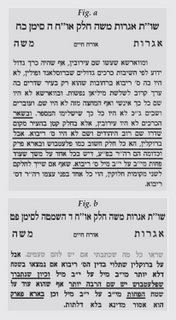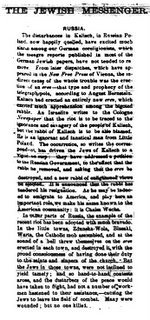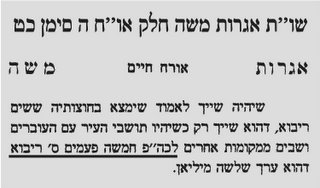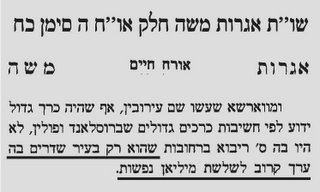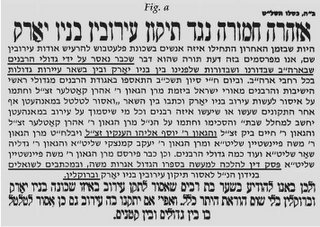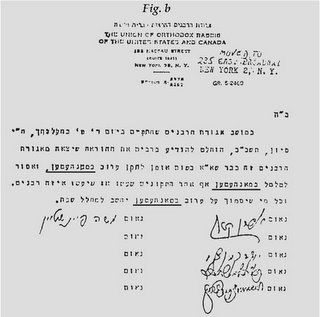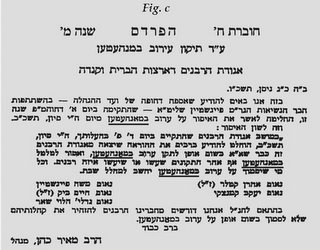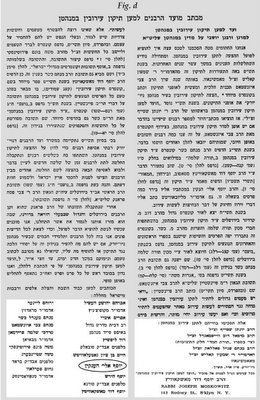"No one is making a gezeira! For that, a Sanhedrin or the like is necessary. R’ Moshe had a concern, which he felt was talmudically sanctioned, that precluded the construction of an eruv in any mega-metropolis. The concern was based on the conceived perception of the unsuspecting and unlearned individual who resided outside the jurisdiction of the would-be eruv. It had nothing to do with the eruv itself! On the last point I would like to say the following: Reb Dovid Feinstein’s name is mentioned in this booklet a few times. But, all that is quoted in his name is anecdotal and must therefore be discounted. I would, however, ask this of those who see him as support for their cause: If what you are saying of Reb Dovid Feinstein is true, then surely he must be an ardent supporter of the eruv in Brooklyn? But to the best of my knowledge only the contrary is true."
Rav Moshe zt"l writes (Igros Moshe, O.C. 4:88) that we find that Chazal enacted gezeiros not to establish eruvin (he wrote this in regards to his opinion about not erecting eruvin in large communities with fewer than 3,000,000 people, since some might think that there is shishim ribo therein). It’s surprising that Rav Hirsch would fail to notice that Rav Moshe himself considered this matter a gezeira.
Nowhere is it stated in Eruvin in Brooklyn that Rav Dovid shlita supports an eruv there. However as Rav Hirsch states (see comment 4) “Different aspects of any argument may be accepted or rejected, without having to accept the entire thesis … one may find one point valid and the other not.” Therefore, we can accept parts of Rav Dovid’s argument’s such as his claim that his father’s shita is that the area requires 3,000,000 and we don’t have to agree with his conclusion. Unfortunately, since there are political (as well as halachic) considerations involved, statements made regarding a different city are more credible than statements made regarding Brooklyn. Since Rav Dovid maintained -- according to his reading of his father’s teshuvos -- that an eruv can be established in Chicago, since the population is less then 3,000,000, therefore by extension an eruv can be erected in Brooklyn as well.
Page 7 comment 26:
"Because Queens is mentioned in this booklet a number of times but is never accurately portrayed, it is worthwhile to set the record straight. Queens is both larger in size and smaller in population than Brooklyn – much smaller. Its population current to the time of the responsum (1974) was 1.9 million, making the number of people living in Brooklyn in excess of those living in Queens greater than the entire population of both Boston (589,141) and Denver (554,600). Queens was the last borough of New York City to be developed, hence the many cemeteries and park, e.g. Shea Stadium, Arthur Ash, etc. It is the most spacious of the boroughs. More importantly, Queens was incorporated into the city not as a whole unit, but as a set of disparate neighborhoods that was then absorbed. As a popular travel guide (2004 ed.) put it: “ a vestige to the borough’s past as a collection of unincorporated villages.” This also explains the open spaces between different neighborhoods, a phenomenon found nowhere else in New York City. This alone was the decisive factor upon which R’ Moshe permitted the Kew Gardens (Hills) eruv, as stated in his 1974 teshuvah to R’ Peretz Steinberg. None of this has any relevance to Brooklyn."
The only decisive fact that Rav Moshe zt”l states regarding Kew Gardens Hills is that it was a small neighborhood in Queens (Igros Moshe, O.C. 4:86 and Addendum to O.C. 4:89). Rav Moshe never claimed that Kew Gardens was a separate entity and it’s a wonder that Rav Hirsch would assert otherwise. This claim regarding the evolution of Queens into a borough of NYC is totally irrelevant and was concocted as an excuse after the fact. There is no trace of it in any teshuvah from Rav Moshe. Additionally, Queens today has over 2.2 million residents and Brooklyn in the 1990’s had approximately the same number. Why was an eruv not allowed in Brooklyn then? More so, why didn’t Rav Moshe object to an eruv in Queens because some, “unsuspecting and unlearned individual who resided outside the jurisdiction of the would-be eruv (see comment 25),” would think that there is shishim ribo therein? It’s important to note that, Rav Moshe wanted to enact this gezeira in Detroit proper (ibid., 5:29) with a population of approximately 1.2 million, which is much less than Queens! The only satisfactory answer is that Rav Moshe allowed an eruv in Kew Gardens Hills since the tzuras hapesachim demarcated a small part of Queens from the rest of the borough. Therefore, there is no reason, according to Rav Moshe, not to allow an eruv of tzuras hapesachim to separate a section of Brooklyn such as Flatbush from the rest of the borough (see Brooklyn and Queens: Same or Different? and Does the Eruv Encompass Shishim Ribo).
Page 8 comment 27:
"This is bona-fide nonsense! New York City is comprised of close to 100 neighborhoods; Brooklyn, of nearly a score. Red Hook, Sunset Park, Bergen Beach, Bay Ridge, Carol Hills, Dyker Heights to mention a few Brooklyn neighborhoods. Boro Park is one small part of one borough out of five, which comprises New York City. No marginally informed semi-educated individual would entertain the notion that, between the two neighborhoods of Boro Park and Flatbush, six million out of eight million New York City inhabitants reside. Certainaly not a man as sagacious and responsible as R’ Moshe. All that R’ Moshe meant was that Flatbush/Boro Park are neighborhoods whose halachic identity extends beyond their geographic borders, encompassing the entire Brooklyn, as concerns the numerical reckoning for 600,000."
As can be ascertained from the above, Rav Hirsch doesn’t have a better explanation for Rav Moshe zt”l’s statements that both Boro Park and Flatbush contain a population of greater than shishim ribo. Rav Moshe states clearly that both Boro Park and Flatbush encompass an area less than twelve mil by twelve mil and nevertheless they contain more than shishim ribo (see Does the Eruv Encompass Shishim Ribo). On the other hand, Rav Moshe states that Brooklyn includes an area of more than twelve mil by twelve mil (Igros Moshe, O.C. 4:87-88). Consequently, these teshuvos must indicate that each neighborhood independently has shishim ribo and not just the whole of Brooklyn. Therefore, Rav Hirsch’s claim that, “ All that R’ Moshe meant was that Flatbush/Boro Park are neighborhoods whose halachic identity extends beyond their geographic borders, encompassing the entire Brooklyn, as concerns the numerical reckoning for 600,000,” is totally erroneous since Rav Moshe stated that each neighborhood on its own contains shishim ribo.
Page 8 comment 28-30:
Has already been discussed in comment 24-26.
Page 8 comment 31:
"If it is obvious that there is no platya in Brooklyn, then R’ Moshe’s raising of the issue was pointless. He was just outright wrong! This is the fifth or sixth time that this work, although claiming to explain R’ Moshe’s shitah, instead discounts it as erroneous. However, in truth there are many platyos all over New York City. Union Square in Manhattan and Fulton Mall in Brooklyn Heights are two examples. As to the assertion that the Shulchan Aruch and the Achronim have not accepted this shitah, that unfortunately, is untrue. This shitah is none other than the Rashba’s shitah – and none of the Rishonim disagree. Had the writers of this work been familiar with the Nishmas Adam (49:2), they would not have mistakenly penned these few lines. In general, I think they have not fully understood the concept of platya."
Nowhere is it stated in Eruvin in Brooklyn that Rav Moshe zt”l is c”v wrong, only that he was misled regarding certain facts. Does Rav Hirsch offer a better explanation why Rav Moshe stated that there are over a million people who come into Brooklyn to work or that both Boro Park and Flatbush contain a population of more than shishim ribo or that until then (1981) Brooklyn was not encompassed by mechitzos? We have yet to see better answers!!
While this critique is not the place for a full analysis of the shitas HaRashba (in a future post we will elaborate IY”H), we will just cite a few sources that will prove that Rav Hirsch is incorrect. There are some Rishonim who undoubtedly do not agree with the Rashba: Ran, Shabbos 6a; Ramban in Milchamos 6a, and Sefer Habattim, Sha’arei Issur Hotza’a 1:15 (see Kaf HaChaim, 345:35). These are some of the Achronim who clearly state that we don’t pasken like the Rashba: Ma’asas Binyomin, siman 92; She’eilas Yaavetz, siman 7; Ginas Veradim, 3:22; Mayim Rabim, siman 38; Birkei Yosef, 345:1; Bais Ephraim, siman 26; Bais Shlomo, siman 51; Tzemach Tzedek, Shabbos 6a; Maharsham, 1:162; Yeshuos Malko, siman 21, and Kaf HaChaim, 345:35. More so, the Achronim maintain that there is no real platya today either because our cities don’t have a central marketplace (Aruch HaShulchan, 345:22) or because our stores are indoors (Bais Av, 6:2). Consequently, even the Fulton Mall would not be classified as a platya. Additionally, even if there is a platya in Brooklyn, it is only prohibited to carry in the platya itself and not in the rest of the borough since we are excluding any platya in the tzuras hapesachim encompassing our neighborhood (Meiri, Shabbos 6a and Sefer Habattim, Sha’arei Issur Hotza’a 1:15).
